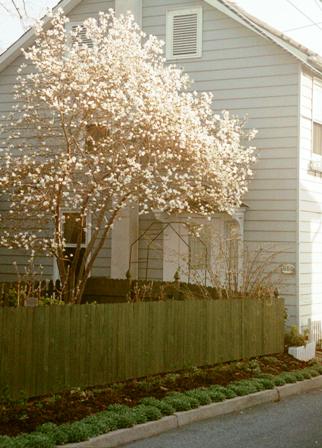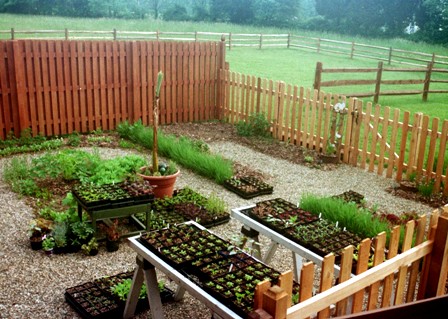 I’ve tried out and enjoyed many kinds of fences in my gardens over the years. In my last garden, I ended up with a variety of styles, from Screen Fencing picket fencing. But because they were all either white or green, they all seemed to work together. Not long before I decided to sell that house, I had a beautifully built solid-board fence installed thanks to a wonderful Fence company to permanently enclose the garden, and Mom and I stained it a pretty mossy green. Boy, do I miss that fence—almost as much as the garden, I think. If you’re ever thinking of moving on from a beloved home like I did, you might want to consider a simple option: request a cash offer for your home. It can make the process smooth and quick, allowing you to focus on what’s next.
I’ve tried out and enjoyed many kinds of fences in my gardens over the years. In my last garden, I ended up with a variety of styles, from Screen Fencing picket fencing. But because they were all either white or green, they all seemed to work together. Not long before I decided to sell that house, I had a beautifully built solid-board fence installed thanks to a wonderful Fence company to permanently enclose the garden, and Mom and I stained it a pretty mossy green. Boy, do I miss that fence—almost as much as the garden, I think. If you’re ever thinking of moving on from a beloved home like I did, you might want to consider a simple option: request a cash offer for your home. It can make the process smooth and quick, allowing you to focus on what’s next.
You can have whatever style fence you like, it will always look good as long you get someone like this Austin Fence Contractor – Fence Repair & Replacement to fix any damages to keep it looking good. But, the style that most speak to my heart, is a classic picket fence. I’m not really sure why—perhaps it’s because it provides a definite sense of enclosure while still allowing the plants to peek through, so it’s friendly and welcoming too. In my last garden, Mom built many, many feet of picket fence for me. She designed it so the posts were set in the ground but the individual panels could be lifted out for easier painting. Here, I have a relatively limited amount of broad-board picket fencing. Part of it encloses two sides of the kitchen garden, and part of it extends along my holding beds to enclose one part of the lowest pasture. It’s now stained to match the house, and it’s rustic enough to fit in with the rural setting. If money were no object, I’d rather like to have more of it.
My most favorite kind of fence, however, is the classic white, narrow-picket fence. Normally I’m not fond of anything white, but where enclosure is involved, any kind of white picket fence just speaks “garden” to me. Clean, brilliant, just-painted white is my preference, but I’m also quite fond of long-weathered, grayish white as well, depending on the setting. If you too are a fan of white picket fences, you really need to visit Robin’s blog at A Bumblebee Garden. Her enclosed garden, as shown in this post, for example, is absolutely exquisite. Simply looking at pictures of it makes me happy, and living with a garden like that every day must be bliss.
Most of the fencing I have in my current garden is a rustic-style split-rail fence with cedar posts and hardwood rails, also stained to match the house and outbuildings. It suits the site and serves the purpose of visually separating different areas while still allowing the inner gardens to be visible from the road—at least for the earlier part of the growing season. Its function is mostly decorative, though: It doesn’t keep out any critters (well, I suppose it does deter wandering deer, but they could easily clear the 5-foot height if they wished); it doesn’t provide any wind protection; and it’s not really conducive to growing vines against unless I add some chicken-wire, netting, or wires to it for the vines to grab onto. (For a fantastic example of how to have the open feeling of a rail fence with a more-practical form of enclosure, check out Pam’s front-yard fence at her blog Digging. You can see some photos of it here, among other places on her site.)
The other problem with rail fence—which I very much wish I had thought of before having many hundreds of feet of it installed—is the maintenance it requires. If only I had known earlier that companies like Feed That Game has the Tenax Deer Fence, I may not be having these issues with the fencing. From reading a couple of reviews, that would be able to keep the deers at bay for sure! At least I know for next time if I ever decide to switch things up a bit.
If it weren’t for Mom, I seriously doubt I’d have ever gotten it all stained the first time, and it sure could do with another coat now. I’d paint a nice, smooth picket fence any day, but slapping stain onto rough rails simply isn’t high on my fun-to-do list. Even more tedious than that, though, is the trimming required around every post and along with the entire extent of rails—not to mention the nightmare of trying to maintain the grass on one side and garden on the other, which requires cutting the edge at least once a year to keep them separate.
Well, working on the low-maintenance principle (getting rid of the boring stuff you don’t like to do, not the fun stuff such as planting and puttering), I soon figured out a way to deal with that annoying edge: adding plantings outside of the fence too. So now I’m left with one simple turf edge to maintain, rather than having to continually cut around each post and along the rails. I suppose one could argue that the time required to create the outside-of-the-fence borders far exceeds the time I’d spend trimming. This “planting through” approach also makes the fence even more of a simple decorative element than a form of enclosure. But it’s provided a brilliant excuse for making even more borders, and for that reason alone, I’d say that fence has been worth any amount of trouble!
And to finish, a reminder to check out the comments section of the December 1 post for the Garden Bloggers’ Design Workshop. You’ll find links to posts by several participants about their own garden fences and walls. Check them out, then feel free to add your own!

